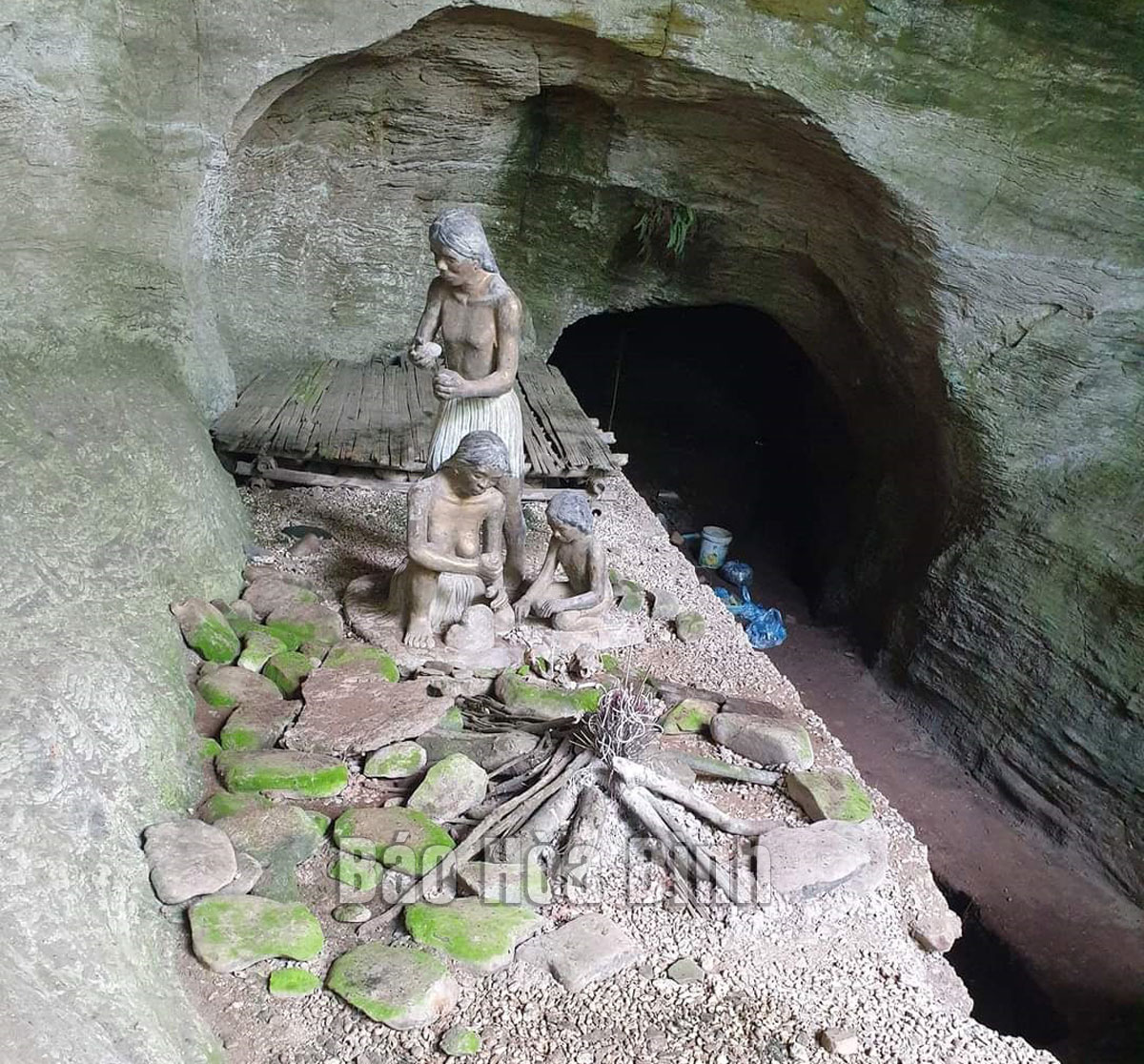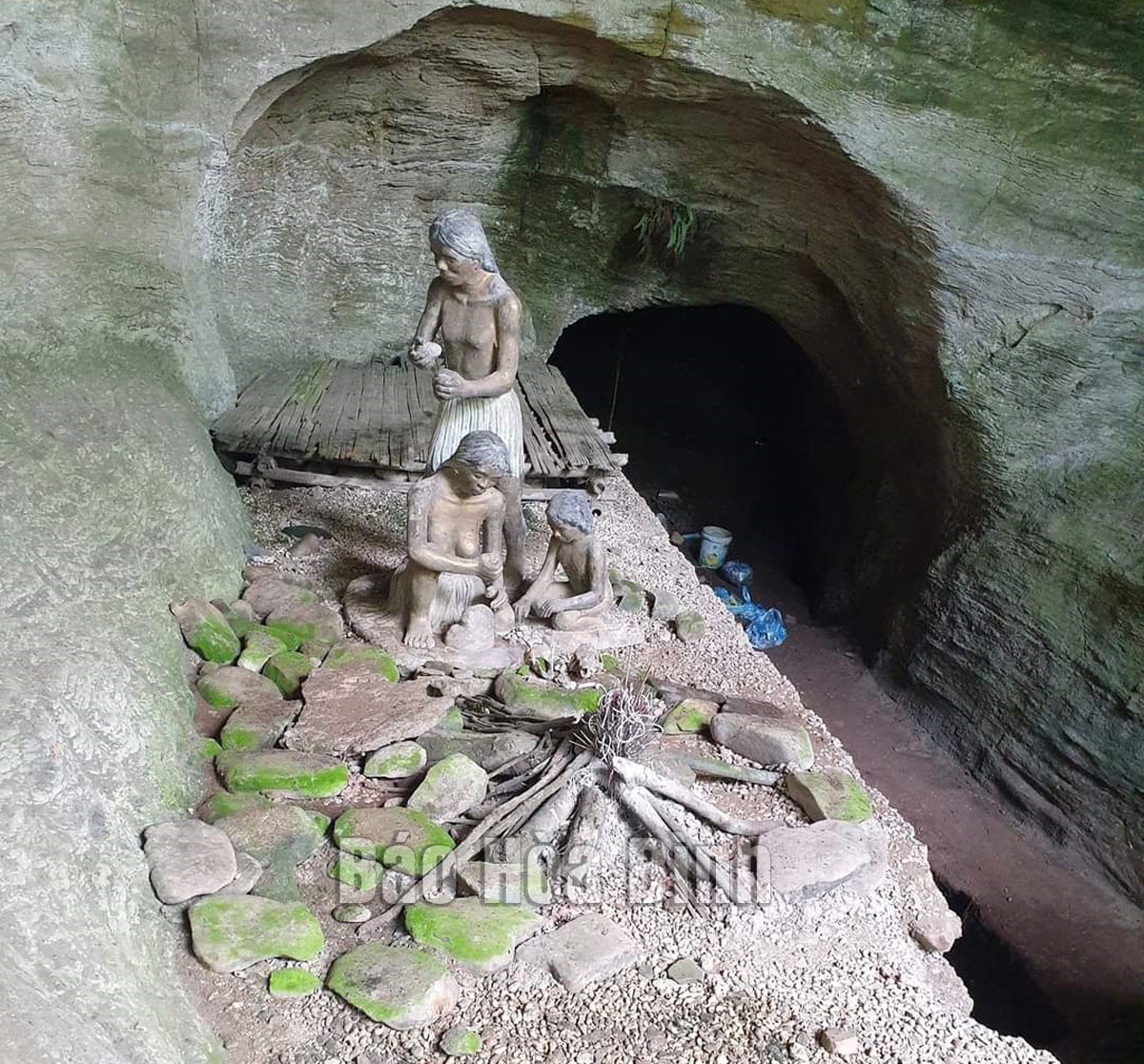
(HBO) – The Hoa Binh Civilisation, dating back to the Stone Age, was discovered by French archaeologist Madeleine Colani and named after the cave relics found in the karst areas of Hoa Binh province. In Vietnam, its traces have been unearthed mostly in Hoa Binh and Thanh Hoa provinces (over 80% of the total relics), while the rest scatter in the provinces of Thai Nguyen, Lai Chau, Son La, Ninh Binh, Ha Nam, Nghe An, Ha Tinh, Quang Ninh, Quang Binh, Quang Tri, and some others. Not only in Vietnam, this civilisation also existed across the mainland Southeast Asia, from southern China to Sumatra Island of Indonesia, Myanmar, and the Philippines.
A demonstration of the life of primitive humans at Xom
Trai Cave in Tan Lap commune, Lac Son district.
The reason for the concentration of Hoa Binh
Civilisation relics in Hoa Binh and Thanh Hoa is that local karst areas had
stable and consistent geological features, and they were also located in the
transition zone of the northern, western and southern geological regions. That
blessed the two provinces with diverse and complex natural conditions as well
as creature richness, resulting in food abundance.
Caves and rock shelters of the Hoa Binh
Civilisation were located at about 15 - 20 metres above the valley’s bed. The
residential space of people at that time varied according to relic sites. Some
caves and shelters are 10 square metres wide while others cover thousands of
square metres, but most have an area of 50 - 150 square metres. Those places
were also lit and warmed by sunlight in the morning. More than 90% of those
sites could keep their inhabitants from cold northwest winds in winter.
Late Professor Tran Quoc Vuong highly valued the
residential locations of the Hoa Binh Civilisation people, saying those places
were the prerequisite for primitive humans to develop agriculture and move to
lowland areas to develop a new civilisation.
Archaeological documents and excavations showed
that hunting and foraging were the main ways of subsistence of people of this
civilisation. Those activities mainly took place in valleys.
Working tools in the Hoa Binh Civilisation were
made from wood, bamboo and pebble. When finding places to reside in, apart from
choosing the sites with necessary natural conditions like sunlight, rivers, and
streams, people at that time also paid special attention to those near pebble
and limestone sources to make working tools.
Archaeological findings also revealed that women
played the main role in creating working tools while men were in charge of
hunting. Women also hunted small animals and mollusk, and picked vegetables and
fruit, which were not as hard as men’s work but generated high economic value.
Women were also responsible for bringing up children, sustaining fire, cooking,
and storing food. Therefore, women’s role gradually became important and
indispensable in each cave of primitive humans.
Ninety years have passed since the discovery of
the Hoa Binh Civilisation, but there remain a number of questions waiting for
answers about this civilisation before a panorama of the society in that period
could take shape./.
Hoa Binh province has carried out multiple programmes and initiatives to revive its cultural heritage which has gradually fallen into oblivion through the ebbs and flows of history.
The most prominent and defining feature in the prehistoric era of Hoa Binh is the Hoa Binh Culture. The Culture was first discovered in Hoa Binh. The significant prehistoric culture represents not only Vietnam but also Southeast Asia and southern China. Through excavations of cave sites in the limestone regions of Hoa Binh, French archaeologist M. Colani introduced the world to a "Stone Age in Hoa Binh province – Northern Vietnam" in 1927. On January 30, 1932, the First Congress of Far Eastern Prehistorians, held in Hanoi, officially recognised the Hoa Binh Culture.
Known as the "Land of Epic History”, Hoa Binh province, the gateway to Vietnam’s northwest, boasts a strategic location and a unique cultural tapestry woven by its ethnic minority communities.
The People's Committee of Luong Son District recently held a ceremony to receive the certificate recognizing Sau Communal House in Thanh Cao Commune as a provincial-level historical and cultural site.
Recognising the importance of cultural heritage preservation in protecting and promoting the value system of Vietnamese culture, and serving socio-economic development in the new period, Party committees and local administrations in Hoa Binh province have identified it as a key task in the cultural development strategy. The province has been making efforts in mobilising resources, creating consensus among people and engaging ethnic communities in preserving and promoting cultural identity.
Hoa Binh province has captured growing attention both domestically and internationally for its distinctive cultural heritage and rich history. Most notably, it has been renowned for its famous Hoa Binh culture, considered the cradle of ancient Vietnamese civilisation. Looking ahead to significant milestones in 2025 and the 140th anniversary of province establishment in 2026, Hoa Binh Newspaper presents a comprehensive overview of the province's development across economic, social, cultural, tourism, and security domains.



